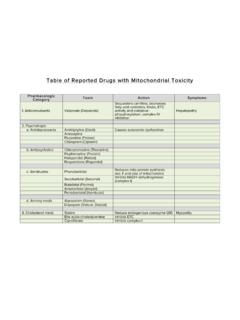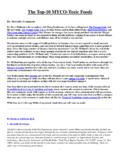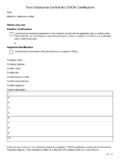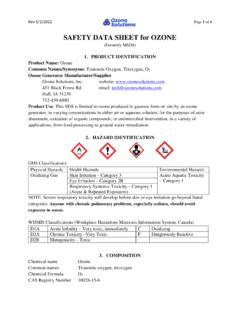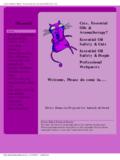Transcription of OECD GUIDELINE FOR THE TESTING OF CHEMICALS
1 Paris 28 November 2008 OECD GUIDELINE FOR THE TESTING OF CHEMICALS DRAFT PROPOSAL FOR A NEW GUIDELINE : 436 Acute Inhalation Toxicity - Acute toxic Class (ATC) Method INTRODUCTION 1. OECD guidelines for the TESTING of CHEMICALS are periodically reviewed in the light of scientific progress, changing regulatory needs and animal welfare considerations. The first acute inhalation Test GUIDELINE 403 was adopted in 1981, and has since been revised (1). Development of an Inhalation Acute toxic Class (ATC) method (2)(3)(4) was considered appropriate following the adoption of the revised oral ATC method (TG 423)(5) in December 2001.
2 A retrospective validation study of the acute toxic class TESTING method for acute inhalation toxicity showed that the method is suitable for being used for Classification and Labelling purposes (6). The inhalation ATC GUIDELINE will allow the use of serial steps of fixed target concentrations to provide a ranking of test article toxicity. Lethality is used as key endpoint. However, animals in severe pain or distress, suffering or impending death should be humanely killed to minimize suffering.
3 Guidance on humane endpoints is available in the OECD Guidance Document No. 19 (7). 2. Guidance on the conduct and interpretation of the TG 436 can be found in the Guidance Document on Acute Inhalation Toxicity TESTING (8). 3. Definitions used in the context of this GUIDELINE are provided in Annex 1. 4. The method provides information on the hazardous properties and allows the substance to be ranked and classified according to the United Nations (UN) Globally Harmonized System of Classification and Labelling of CHEMICALS (GHS) for the classification of CHEMICALS that cause acute toxicity (9).
4 In case point estimates of LC50-values or concentration-response analyses are required, Test GUIDELINE 403 is the appropriate Test GUIDELINE to use. This Test GUIDELINE is not specifically intended for the TESTING of nano-materials. INITIAL CONSIDERATIONS 5. All available information on the test article should be considered by the TESTING laboratory prior to conducting the study in order to enhance the quality of the study and minimize animal usage. Information that may assist in the selection of appropriate test concentrations include the identity, chemical structure, and physico-chemical properties of the test article; results of any in vitro or in vivo toxicity tests; anticipated use(s) and potential for human exposure; available (Q)SAR data and toxicological data on structurally related substances.
5 PRINCIPLE OF THE TEST 6. It is the principle of the test that based on a stepwise procedure, sufficient information is obtained on the acute inhalation toxicity of the test substance during an exposure period of 4 hours to enable its classification. Other durations of exposure may apply to serve specific regulatory purposes. At any of the defined concentration steps, 3 animals of each sex are tested. Depending on the mortality and/or the 2 moribund status of the animals, more than 2 steps may not be necessary to allow judgement on the acute toxicity of the test substance.
6 If evidence is provided that one gender is more susceptible than the other, then the test may be continued with the more susceptible sex. The outcome of the previous step will determine the following step , a) no further TESTING is needed, b) TESTING of three animals per sex, c) TESTING with 6 animals of the more susceptible sex only , for the lower boundary estimates of the toxic class should be based on 6 animals per test concentration group. 7. Moribund animals, or animals obviously in pain or showing signs of severe and enduring distress should be humanely killed, and are considered in the interpretation of the test results in the same way as animals that died on test.
7 Criteria for making the decision to kill moribund or severely suffering animals, and guidance on the recognition of predictable or impending death, are the subject of a separate Guidance Document on Humane Endpoints (7). Concentrations that are expected to cause severe pain and distress, due to corrosive1 or severely irritant actions, should not be administered (see GD 39). 8. TESTING in GHS Category 5 should only be considered in this context, , when there is a strong likelihood that results from such a test have a direct relevance for protecting human or animal health.
8 If inhalation is not a likely route of exposure to a given material, then reasons for not TESTING by this route should be rationalized (8). DESCRIPTION OF THE METHOD Selection of animal species 9. Healthy young adult animals of commonly used laboratory strains should be employed. The preferred species is the rat. Justifications should be provided if other species are used. Preparation of animals 10. Females should be nulliparous and nonpregnant. On the exposure day, animals should be young adults 8 to 12 weeks of age, and body weights should be within 20% of the mean weight for each sex of any previously exposed animals at the same time point.
9 The animals are randomly selected, marked for individual identification. The animals are kept in their cages for at least 5 days prior to the start of the test to allow for acclimatization to laboratory conditions. Animals should also be acclimatised to the test apparatus for a short period prior to TESTING , as this will lessen the stress caused by introduction to the new environment. Animal husbandry 11. The temperature of the experimental animal maintenance room should be 22 3 C. The relative humidity should ideally be maintained in the range of 30 to 70%.
10 Animals may be group-caged by concentration, but the number of animals per cage should not interfere with clear observation of each animal and should minimize losses due to cannibalism and fighting. The nature of a test article or toxicity ( , morbidity, CNS stimulation) may indicate a need for individual caging to prevent cannibalism. 1 Determined using a validated test method ( , TG 430 (10), 431 (11) or 435 (12)) or an acceptable prediction.











